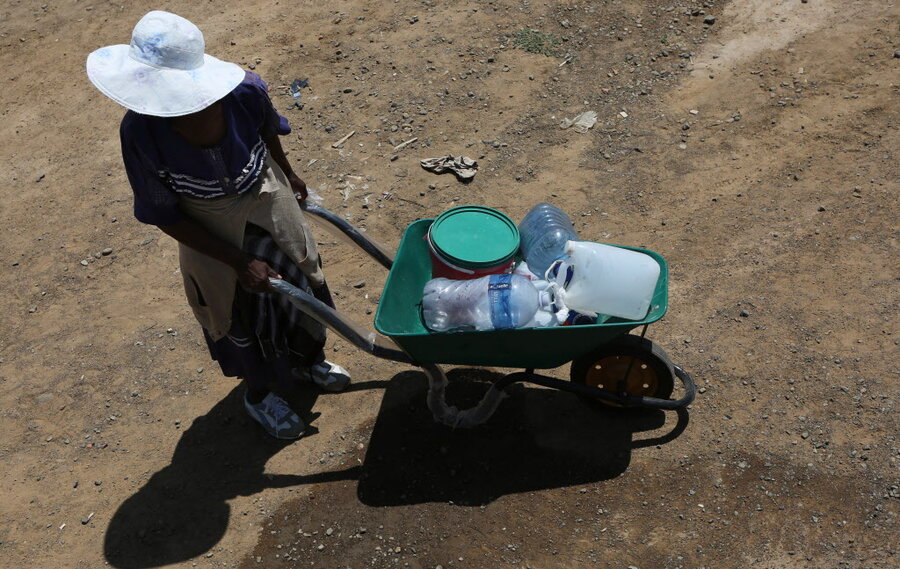Changing harvest outcomes with better crop storage bags
Loading...
In Sub-Saharan Africa, Purdue University’s Department of Entomology has worked with farmers to develop a multilayer plastic crop storage bag called PICS (Purdue Improved Crops Storage) bags. The project, which started its third phase in 2014, provides crop storage bags that are produced locally, are affordable for small farmers, are easy to use, and bolster farmers’ incomes while safeguarding food stores for consumption in emergencies.
Grain storage can be risky for small farmers, particularly in sub-Saharan Africa. According to Sophia Kaduma, the Permanent Secretary in the Tanzania Ministry of Agriculture and Food Security, the “loss of agriculture produce is a challenge not only to the government but [to] farmers, private sector, and stakeholders...”
The Bill & Melinda Gates Foundation funded this five-year program, which includes an awareness campaign for farmers and capacity for farmer training on bag use for multiple crops. The Gates Foundation also funded PICS1 and PICS2.
The ultimate aims are to increase food security among small farmers and to equip the local private sector to “[develop] profitable business in PICS bags,” explains project director Dieudonné Baributsa.
According to the U.N. Food and Agriculture Organization (FAO), moisture, pests, and temperature are three significant threats to stored grains and to food security during the hunger season. But grain losses “can be prevented with simple and effective technology.”
FAO cites that farmers using PICS bags for cowpea storage experienced an average increase in income related to cowpeas of 48 percent. What else is promising about PICS bags?
First, PICS bags keep insects out. After farmers fill the bags with harvested grains, the bags are tied so tightly that an airtight, or hermetic, seal forms. Without new oxygen flow through the bag, the insects inside the bag die and the physical barrier prevents new insects from entering.
By dramatically reducing the threat of pest destruction of stored crop, PICS bags reduce the need for insecticides. Decreased insecticide use is a significant public health benefit in Sub-Saharan Africa where misuse is common. A 2012 report from the U.N. Environmental Programme estimated that the “costs of poisonings from pesticides in sub-Saharan Africa exceeds the total annual overseas development aid given to the region for basic health services.” Decreased reliance on insecticides also translates to lower costs for small farmers.
The bags themselves are economical for many farmers: at about US$1 per bag, PICS bags' yearly cost to farmers is between US$20 and US$40. The University of Greenwich Natural Resources Institute estimates cost per ton per year at between US$5 and US$20. And though they’re three times as expensive as traditional bags, farmers can use them for two to four years, as long as they don’t have any holes. A study of cowpea storage in Niger using PICS Bags found that 79 percent of bags were still in use in their third year.
Another benefit of PICS bags is that they alleviate the need for farmers to sell harvests immediately. Without money to purchase chemicals for harvesting, small rural farmers can feel pressure to sell harvests quickly, in a flooded market while prices are low, to avoid risking losing the crop during storage.
One Ugandan farmer-participant in a PICS bag demonstration discussed this dilemma, concluding that “this innovation will help us to keep our crops and be able to sell them at our convenient time,” potentially protecting farmers against food insecurity post-harvest and increasing income potential.
In addition to bolstering the income potential of small farmers, PICS bags are good for the local economy. Purdue partners with national NGOs to distribute PICS Bags, and seven African plastics manufacturers are now producing the bags. The PICS3 team hopes that “expanding the use of the PICS bags to store other crops will increase business opportunities for the private sector.”
PICS bags are practical for farmers for another reason: they serve as an easily-accessible source of food during times of shortage. Farmers can open them for consumption at any point, and though PICS bags hold 50 or 100 kilograms of grain, they are small and portable enough for farmers to keep them on-farm, or even in their homes.
Awareness is an important component of all the PICS bags campaigns. Media, like PICS bag posters complete with illustrations and recommendations demonstrating proper use of PICS Bags, is helpful. Although the relative simplicity of PICS bags has contributed to their popularity, increasing the number of local dealers of PICS bags and increasing access to demonstrations of their use and effectiveness will be important for maximizing their impact.
This article first appeared at Food Tank.







